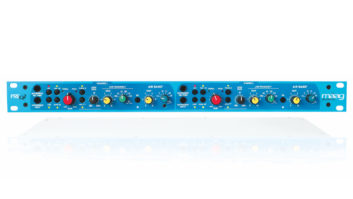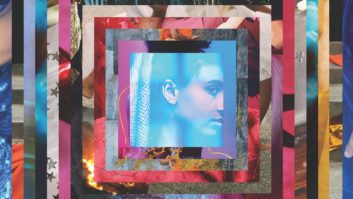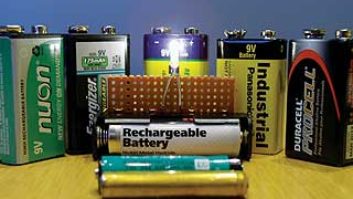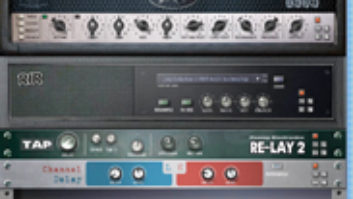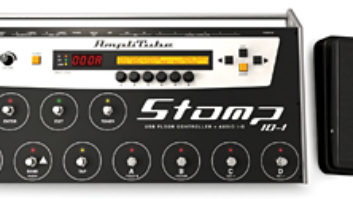
In the minds of its creators — English-men Luke Cresswell andStephen McNicholas — Stomp is a malleable idea aboutrhythm as language, a nonverbal way to communicate through percussion.That concept formed the basis for their celebrated theatrical event,simply called Stomp, and a series of ever-evolving films: theirfirst short Brooms, which was nominated for an Academy Award, anHBO special, and their most ambitious effort so far — therecently released Imax film, Pulse, A Stomp Odyssey. The ideabehind Stomp, according to Cresswell, is, “the challengeof putting a show together that was just rhythm, movement and humor,but definitely not dialog; to try and take the audience on ajourney.”
Currently being performed in five theaters around the world,Stomp involves a small community of skilled performers playingeveryday objects in a kind of infectious, rhythmic back-and-forth;purely abstract, but with a subtext of race and class that fills thetheater with thomps, whacks, scratching, banging and clanging. Over thecourse of an evening, the solos and duets build to larger ensemblepieces and climax in a wonderful, percussive orgy of loud sounds andpowerful rhythms that never fail to bring down the house.
The concept for the Imax film was to expand Stomp‘s reach: totake the show’s creators, technicians and performers around the worldand join the Stomp cast with local performers in a planetary,percussive dialog. “We always had a desire deep down to do aglobal drum-rhythm project,” McNicholas says. “Somethingthat paid tribute to the people who inspired us; for example, the Kododrummers from Japan. We wanted to do something that celebrated greatrhythms of the world.”
In its theatrical form, Stomp required a signature sound.Cresswell and McNicholas turned to their old rock ‘n’ roll bandbuddy-turned audio engineer Mike Roberts to help them figure out whatthe sonic aesthetic would be. “The show creates its ownsound,” Roberts says. “What you have to do is reinforce theenergy and the movement onstage. You are trying to involve the audiencein the space with the lights and the movements.”
The HBO special, Stomp Out Loud, was an elaboration of theaudio techniques employed in the theater. In both the scenes filmedonstage and the location scenes, the miking involved arrays of openmics with only a few radio mics stashed in drums or hard-to-reachplaces. But the wide vistas and the great detail that the Imax cameracaptures required a rethinking of the audio technique for theater. Toget impact meant hiding multiple radio mics on people’s bodies orwithin drums. The open mics — the Sennheiser shotguns thatRoberts loves — would now document ambience and performance.
In any of the larger projects that Cresswell and McNicholascontemplate, Roberts is an integral part. He is there at the very firstplanning stages, and he is also present at the final mix, suggestingthe great range and diversity of his skills. I have worked with theStomp creators and Roberts since 1996, recording or playing backmusic for their commercials, the HBO special and, most recently, theImax film, which was filmed in a variety of locations, includingBrazil, India, South Africa, Spain, the UK and the U.S.
In the large-scale projects, all of the sound that is heard on thescreen is live and direct, with one notable exception: In Pulse,during the scene filmed on New York’s Brooklyn Bridge, what we hear onthe screen is wild sound recorded on location at the end of theshooting day. Producing the sound for that scene reveals all of theperils and challenges of doing location multitrack audio. Inretrospect, it leads us to wonder whether we were arrogant, naive orfoolish to think that we could record usable sound for an Imax film onthe Brooklyn Bridge. At the time, we wondered who was in charge: thebridge or us?
“I was under no illusions about the Brooklyn Bridge,”Roberts confessed later on. “I knew it was going to be hellish.Everything was against us: the weather, the distances, the logistics,the location of the truck. People told me that you can’t do this in acomplicated way.” But because the charge from Stomp‘screators was to bring back live, direct sound, Roberts felt that he hadno choice.
The Brooklyn Bridge scene happened at the end of a grueling’round-the-world adventure during the last few days of shooting on thefilm. It took place in the middle of a New York winter, on a very snowyweekend. It was cold, and daylight was short. The scene itself involvedtwo marching percussion bands — one hip hop and the other aconventional drum band. They were to play on the walkway above thetraffic lanes of the bridge and, at some point, meet near the center ofthe bridge. Because we could not stop traffic, we asked ourselves ifthey could make enough noise to mask the enormous traffic roarbelow.
Chris Anderson brought his multitrack Nevessa sound truck, alongwith a couple of assistants, down from Woodstock. We had used the trucksuccessfully on the HBO special five years earlier. On the scout a fewdays before our setup, the job seemed doable, if daunting. We wouldpark the truck at the base of the Brooklyn tower of the bridge. Thatmeant an enormous multicore cable would need to run up to the bridgefrom the truck — probably 150 to 200 feet — and that wasonly the beginning. We probably ran somewhere between a quarter- and ahalf-mile of cable. That raised the issue of whether mic-level signalswould be of sufficient strength and integrity to reach the inputs ofthe truck’s console. So, we decided to rent an active mic preamp rackto deliver the signals at line-level to the truck. On setup day, wetested everything we could. We had one 8-channel radio mic rack fromSennheiser and two 4-channel quad boxes from Lectrosonic. They workedwell on Friday, but we knew that they wouldn’t necessarily work as wellon the shoot. We tested all of our open mics, all of the mic lines, thesimple stereo rig — consisting of a Fostex PD-4 and the NeumanM-S stereo mic — the active preamp rack and all 52 lines of theaudio snake. It all worked.
We set up on Friday, but by that afternoon, we got word that snowwas expected the next day and, as a consequence, we would have to filmon Sunday rather than Saturday. All valuable items had to come off ofthe bridge, leaving only cables and the 52-pair snake.
Our seven-person crew started work at 5:30 a.m. Sunday morning. Iassigned myself the cushy job of working with Anderson in the heatedNevessa truck, monitoring the recording, while Roberts took his fourguys up to the bridge to set up in the cold and dark. By 7 a.m.,though, the walkie crackled with Robert’s voice: He needed me on thebridge. I left Anderson alone to run his truck, knowing I probablywould not return.
Once on the bridge, I noticed that the PD-4 stereo rig had not beenset up, let alone tested. Then, as the day progressed, necessitydictated that the bands be placed closer and closer to the Manhattanside — further and further away from our staging area. Cable runsgrew longer, radio mic signals grew weaker and our anxiety levelsincreased.
Even as the sun was rising that morning, gaining light was in theback of everyone’s mind. Getting a good, live multi-track sound isnormally a major priority for the Stomp directors, but it wasclear that on this day, archiving images — not recording sound— was paramount. There were two elements to the recording we weredoing: Impact was to be handled by the radio mics placed on selectiveperformers, and space was to be captured by the array of shotgun micswe placed along the walkway. But because the radio mics were performingso erratically, we knew that we wouldn’t get much impact, at least on aconsistent basis. And we soon found out that the walkway wasn’t wideenough to permit us to hide the elaborate shotgun array that we hadplanned from the ever-seeing Imax camera during a turnaround shot. Thewild sound recording would make or break our day.
“It was the toughest day’s work I have ever done,”Roberts admits. “It was a pretty terrifying environment. Lookingback, I probably pushed people too hard, trying for a result we werenever going to get. It was a very ambitious effort. I am slightlydisappointed because it is the one event where we used wild track, butI am [still] very pleased with the outcome.” During the editing,co-director McNicholas saw the Brooklyn Bridge scene spring to lifewith the wild sound. “Whenever we mention the BrooklynBridge,” he says, “Mike’s eyes light up.”
The Stomp team left New York after the last day of shootingand started editing immediately in England. Cresswell and McNicholasedited the film themselves on Final Cut Pro. Once reasonably sure of acut, they would bring Roberts into the process. He described theparallel picture editing and sound construction as “working rightto the edge of the technologies. We all have the same media —about 150 gigabytes of video media. They e-mail me the edit as areference movie. What Final Cut Pro gives me is the ability to look atthe cut, any scene. I stream the video in from Final Cut Pro into myPro Tools AV, using Final Cut Pro to get my sync references. I thenlift the audio from my DA-88s and conform that to picture in Pro ToolsAV. So I am building the edit changes and gradually building up theprogram in Pro Tools AV.”
By the time Pulse was ready to be mixed, what had started outas a relatively linear percussion journey around the world had nowevolved into a far more complicated structure in which the visual andemotional connections were made through cross-cutting and geographicleaps, bound together by a powerful, pulsating soundtrack. Thesoundtrack itself grew in complexity along with the picture. In somescenes, especially the ending, Roberts brought to the first of twomixes as many as 64 tracks.
Pulse was to be completed by the end of spring 2002 for anearly summer release, but the demands of editing pushed the releasedate back substantially. That played havoc with the final mix dates forthe film, and the Imax room at De Lane Lea Studios in London, wherethey had planned to take the project, was not available. Roberts andhis directors decided on a two-pronged strategy for the mix. The musicwould be brought to another longtime colleague, Sven Taits, at De LaneLea for a mix to Dolby 5.1 and those stems would travel across theocean to be finalized into the Imax format, with its five discretetracks and a sub, in Toronto at Masters Sound, Imax’s home.
Of all the pieces Taits mixed, he was most drawn to a brief,underwater musical sequence filmed in the U.S.: Cresswell joins hisStomp cast members banging out rhythms below the surface of alarge outdoor tank in Burbank, Calif., at the end of a busy week inwhich the team also filmed in the Mojave Desert and the Paramountbacklot. “Both Luke and I are very keen scuba divers,”McNicholas says. (So is Roberts.) “We’ve always been interestedin the way sound travels at different speeds underwater, the effectsyou get with bubbles underwater, the way metal hits underwater. Also,because it’s Imax, we have to have helicopter and underwatershots,” he jokes.
The piece was recorded with a pair of B&K hydrophones augmentedby four waterproofed Countryman B-3 mics. When the piece arrived at themix, Taits didn’t have to do much to it. “I EQ’d it a littlebit,” he says. “As the track goes on, I started adding someeffects to give it some shape. The choice of microphones worked verywell. No one is going to believe that this was recordedlive.”
While Brian Eimer, who did the final Imax mix in Toronto, facedchallenges, he was also presented with a gift: He had the opportunityto mix a direct-sound film, which is unusual in the Imax world.“Pulse is by far the most production sound we have everreceived on a project. It’s not something you can emulate in the studioafter the fact. It would certainly take away from the performances onthe screen. You wouldn’t enjoy the journey as much.
“There was a real opportunity in this one to play with the 3-Dspace of the theater and create a surround field for the mix,”Eimer continues. “As the music was mixed, we had to make surethat the positioning of the performance elements be kept forward. Atthe same time, we needed to feel the transition from one environment toanother. For example, when we went to New York, we really made sure tohave a presence of that [place], and when we went to South Africa, wereally felt that we were in that location.”
Pulse, A Stomp Odyssey is a short film, lasting around 40minutes, yet it challenged everyone involved to work to the peak oftheir abilities. At the end of the day, what satisfies most is theknowledge that our technical skills were brought to bear on a vast andentertaining canvas that contains a serious and, we would like tothink, important ambition: to celebrate life and brotherhood. Its goal,as McNicholas notes, “is to link arms with the rest of theworld.” To highlight that theme, the film premiered at a UnitedNations-sponsored event at New York’s Museum of Natural History in thefall of 2002.

Shooting on the Brooklyn Bridge proved to be quite a challenge for theStomp crew.

Protecting the gear was crucial.

On location for Stomp’s underwater sequence.

Engineers doing double-duty as scuba divers.

Setting up the hydrophone location audio rigs.

Recommended Mix reading:
If you liked this article, check out these features on audio forIMAX:
Scoringfor the Biggest Screen: Composer/Engineer SteveWood ClimbsEverest and Swims to the Bottom of The Living Sea.
IMAX’sALL ACCESS: Front Row, Backstage Showcases Rock Legends,Today’s Superstars—Up Close and Live!
